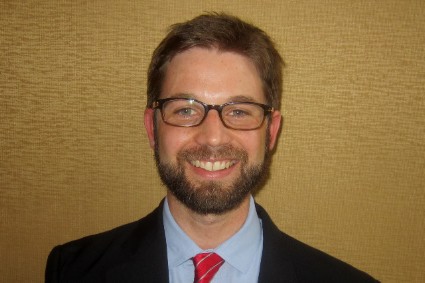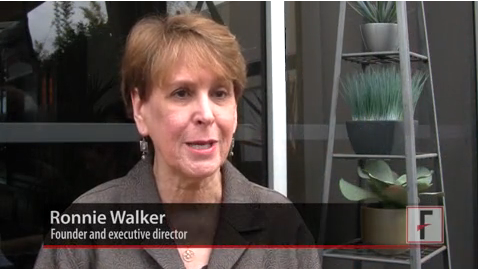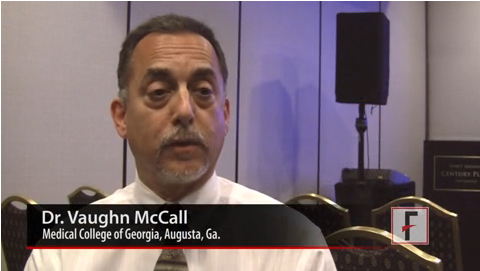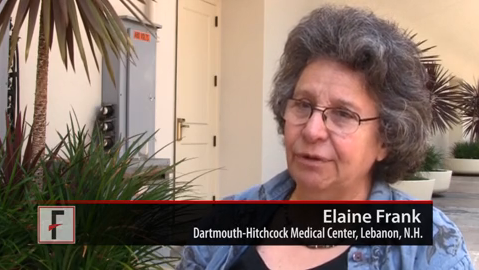User login
American Association of Suicidology (AAS): Annual Conference
VIDEO: Shedding stigma for advocacy, suicide attempt survivors find a voice
LOS ANGELES – Suicide attempt survivors are overcoming the stigma of talking about their attempts and joining together to demand a voice in suicide prevention efforts. Researchers and leaders in the field are hearing that voice and acknowledging them as sources of insight and advocacy that, for too long, have been largely ignored.
Among the signs of that shift – and due largely to their lobbying – the American Association of Suicidology (AAS) recently formed a division for attempt-survivors and launched a blog on the topic.
"It’s a critical voice. There’s no better advocate for mental well-being than someone who has been on the edge of life and death and chosen a path of recovery," said AAS President William Schmitz Jr., Psy.D.
Asked for an example of how this new voice might help, he noted that "there are a lot of clinicians out there who are not trained in the assessment and management of suicidality. I’ve heard stories from some of our attempt survivors that are truly scary – very negative, hostile encounters with the health care system." People who’ve experienced it firsthand offer "a chance for us to open that dialogue," he said at the annual conference of the American Association of Suicidology.
Cara Anna, a journalist and attempt-survivor who helped spearhead the AAS lobbying campaign, stated her case for us at the meeting. She’s a prominent voice in the attempt-survivor community.
The video associated with this article is no longer available on this site. Please view all of our videos on the MDedge YouTube channel
LOS ANGELES – Suicide attempt survivors are overcoming the stigma of talking about their attempts and joining together to demand a voice in suicide prevention efforts. Researchers and leaders in the field are hearing that voice and acknowledging them as sources of insight and advocacy that, for too long, have been largely ignored.
Among the signs of that shift – and due largely to their lobbying – the American Association of Suicidology (AAS) recently formed a division for attempt-survivors and launched a blog on the topic.
"It’s a critical voice. There’s no better advocate for mental well-being than someone who has been on the edge of life and death and chosen a path of recovery," said AAS President William Schmitz Jr., Psy.D.
Asked for an example of how this new voice might help, he noted that "there are a lot of clinicians out there who are not trained in the assessment and management of suicidality. I’ve heard stories from some of our attempt survivors that are truly scary – very negative, hostile encounters with the health care system." People who’ve experienced it firsthand offer "a chance for us to open that dialogue," he said at the annual conference of the American Association of Suicidology.
Cara Anna, a journalist and attempt-survivor who helped spearhead the AAS lobbying campaign, stated her case for us at the meeting. She’s a prominent voice in the attempt-survivor community.
The video associated with this article is no longer available on this site. Please view all of our videos on the MDedge YouTube channel
LOS ANGELES – Suicide attempt survivors are overcoming the stigma of talking about their attempts and joining together to demand a voice in suicide prevention efforts. Researchers and leaders in the field are hearing that voice and acknowledging them as sources of insight and advocacy that, for too long, have been largely ignored.
Among the signs of that shift – and due largely to their lobbying – the American Association of Suicidology (AAS) recently formed a division for attempt-survivors and launched a blog on the topic.
"It’s a critical voice. There’s no better advocate for mental well-being than someone who has been on the edge of life and death and chosen a path of recovery," said AAS President William Schmitz Jr., Psy.D.
Asked for an example of how this new voice might help, he noted that "there are a lot of clinicians out there who are not trained in the assessment and management of suicidality. I’ve heard stories from some of our attempt survivors that are truly scary – very negative, hostile encounters with the health care system." People who’ve experienced it firsthand offer "a chance for us to open that dialogue," he said at the annual conference of the American Association of Suicidology.
Cara Anna, a journalist and attempt-survivor who helped spearhead the AAS lobbying campaign, stated her case for us at the meeting. She’s a prominent voice in the attempt-survivor community.
The video associated with this article is no longer available on this site. Please view all of our videos on the MDedge YouTube channel
AT THE ANNUAL AAS CONFERENCE
Automated screening system might detect suicidality after trauma
LOS ANGELES – About half of trauma patients report suicidal ideation within a year of their injury, and about 20% do so at any given time during that year, according to an investigation of 206 patients at Harborview Medical Center, the University of Washington’s Level I trauma center in Seattle.
A patient’s ties to assault and some of the other risk factors identified in the study could be spotted automatically by electronic medical records (EMR) systems. With a few programming tweaks, records systems can alert clinicians to those most likely to be considering suicide so preventive steps can be taken, said lead investigator Stephen S. O’Connor, Ph.D., formerly of the University of Washington, but now with the department of psychological sciences at Western Kentucky University, in Bowling Green.
"We feel that this is a really pressing need. Suicidality is endemic within the trauma population, and a lot of it is under the radar." An automated screening system might prevent suicidal people from falling through the cracks amid the tumult of trauma and follow-up care, he said at the annual conference of the American Association of Suicidology.
At some point during the 12-month investigation, 101 (49%) patients acknowledged that they had thought they’d be better off dead or had thought about hurting themselves, as assessed by the Patient Health Questionnaire-9.
About 26% admitted to those feelings while in the hospital, and the number dipped only moderately during regular, semimonthly reassessments, with 18% of the sample acknowledging suicidal thoughts at month 12.
While in the hospital, suicidal ideation was predicted by a previous mental health visit (relative risk,1.89; 95% confidence interval, 1.02-3.5; P = .04); total score on the Personal Health Questionnaire Depression Scale-8 (RR ,1.12; 95% CI 1.07-1.19; P less than .001); and general mental health function on the Short Form Health Survey-12 (RR, 0.98; 95% CI 0.97-1.00; P = .04). There was also a nonsignificant trend for injury severity.
Having children was protective (RR, 0.55; 95% CI 0.35-0.85; P = .01).
After discharge, patients who had been assaulted were most likely to be considering suicide (RR 2.03; 95% CI 1.28-3.20; P less than 0.01), as were patients who had injury-related legal proceedings (RR, 4.32; 95% CI 2.24-8.33; P less than .001), thoughts of suicide while in the hospital (RR, 3.34; 95% CI 2.28-4.89; P less than .001), and histories of PTSD (posttraumatic stress disorder) (RR, 1.72; 95% CI 1.09-2.71; P = .02).
Being older (RR, 1.03; 95% CI 1.01-1.04; P less than .001) and in pain (RR, 1.11; 95% CI 1.00-1.22; P = .05) also increased the risk. Once again, a nonsignificant trend was found for injury severity.
"Many of these are the kinds of risk factors that you could pick up from sweeping the EMR. Being assaulted by someone quickly gets an ICD code," for instance, Dr. O’Connor said.
Harborview "already has an automated screening system for PTSD; you could do the same thing with suicidal ideation. We’re moving in that direction," he said, noting that the efforts, besides saving lives, would help meet the Joint Commission’s call for better identification of suicidal patients.
Data for the analysis came from a previous PTSD intervention trial at Harborview. All of the subjects had screened positive for PTSD at 1 month, as part of the earlier work. They were about 38 years old on average, about half were women, and about half had completed high school. About a quarter of the subjects reported annual incomes of $30,000 or more.
Dr. O’Connor has no relevant disclosures. The work was funded by the National Institutes of Health.
LOS ANGELES – About half of trauma patients report suicidal ideation within a year of their injury, and about 20% do so at any given time during that year, according to an investigation of 206 patients at Harborview Medical Center, the University of Washington’s Level I trauma center in Seattle.
A patient’s ties to assault and some of the other risk factors identified in the study could be spotted automatically by electronic medical records (EMR) systems. With a few programming tweaks, records systems can alert clinicians to those most likely to be considering suicide so preventive steps can be taken, said lead investigator Stephen S. O’Connor, Ph.D., formerly of the University of Washington, but now with the department of psychological sciences at Western Kentucky University, in Bowling Green.
"We feel that this is a really pressing need. Suicidality is endemic within the trauma population, and a lot of it is under the radar." An automated screening system might prevent suicidal people from falling through the cracks amid the tumult of trauma and follow-up care, he said at the annual conference of the American Association of Suicidology.
At some point during the 12-month investigation, 101 (49%) patients acknowledged that they had thought they’d be better off dead or had thought about hurting themselves, as assessed by the Patient Health Questionnaire-9.
About 26% admitted to those feelings while in the hospital, and the number dipped only moderately during regular, semimonthly reassessments, with 18% of the sample acknowledging suicidal thoughts at month 12.
While in the hospital, suicidal ideation was predicted by a previous mental health visit (relative risk,1.89; 95% confidence interval, 1.02-3.5; P = .04); total score on the Personal Health Questionnaire Depression Scale-8 (RR ,1.12; 95% CI 1.07-1.19; P less than .001); and general mental health function on the Short Form Health Survey-12 (RR, 0.98; 95% CI 0.97-1.00; P = .04). There was also a nonsignificant trend for injury severity.
Having children was protective (RR, 0.55; 95% CI 0.35-0.85; P = .01).
After discharge, patients who had been assaulted were most likely to be considering suicide (RR 2.03; 95% CI 1.28-3.20; P less than 0.01), as were patients who had injury-related legal proceedings (RR, 4.32; 95% CI 2.24-8.33; P less than .001), thoughts of suicide while in the hospital (RR, 3.34; 95% CI 2.28-4.89; P less than .001), and histories of PTSD (posttraumatic stress disorder) (RR, 1.72; 95% CI 1.09-2.71; P = .02).
Being older (RR, 1.03; 95% CI 1.01-1.04; P less than .001) and in pain (RR, 1.11; 95% CI 1.00-1.22; P = .05) also increased the risk. Once again, a nonsignificant trend was found for injury severity.
"Many of these are the kinds of risk factors that you could pick up from sweeping the EMR. Being assaulted by someone quickly gets an ICD code," for instance, Dr. O’Connor said.
Harborview "already has an automated screening system for PTSD; you could do the same thing with suicidal ideation. We’re moving in that direction," he said, noting that the efforts, besides saving lives, would help meet the Joint Commission’s call for better identification of suicidal patients.
Data for the analysis came from a previous PTSD intervention trial at Harborview. All of the subjects had screened positive for PTSD at 1 month, as part of the earlier work. They were about 38 years old on average, about half were women, and about half had completed high school. About a quarter of the subjects reported annual incomes of $30,000 or more.
Dr. O’Connor has no relevant disclosures. The work was funded by the National Institutes of Health.
LOS ANGELES – About half of trauma patients report suicidal ideation within a year of their injury, and about 20% do so at any given time during that year, according to an investigation of 206 patients at Harborview Medical Center, the University of Washington’s Level I trauma center in Seattle.
A patient’s ties to assault and some of the other risk factors identified in the study could be spotted automatically by electronic medical records (EMR) systems. With a few programming tweaks, records systems can alert clinicians to those most likely to be considering suicide so preventive steps can be taken, said lead investigator Stephen S. O’Connor, Ph.D., formerly of the University of Washington, but now with the department of psychological sciences at Western Kentucky University, in Bowling Green.
"We feel that this is a really pressing need. Suicidality is endemic within the trauma population, and a lot of it is under the radar." An automated screening system might prevent suicidal people from falling through the cracks amid the tumult of trauma and follow-up care, he said at the annual conference of the American Association of Suicidology.
At some point during the 12-month investigation, 101 (49%) patients acknowledged that they had thought they’d be better off dead or had thought about hurting themselves, as assessed by the Patient Health Questionnaire-9.
About 26% admitted to those feelings while in the hospital, and the number dipped only moderately during regular, semimonthly reassessments, with 18% of the sample acknowledging suicidal thoughts at month 12.
While in the hospital, suicidal ideation was predicted by a previous mental health visit (relative risk,1.89; 95% confidence interval, 1.02-3.5; P = .04); total score on the Personal Health Questionnaire Depression Scale-8 (RR ,1.12; 95% CI 1.07-1.19; P less than .001); and general mental health function on the Short Form Health Survey-12 (RR, 0.98; 95% CI 0.97-1.00; P = .04). There was also a nonsignificant trend for injury severity.
Having children was protective (RR, 0.55; 95% CI 0.35-0.85; P = .01).
After discharge, patients who had been assaulted were most likely to be considering suicide (RR 2.03; 95% CI 1.28-3.20; P less than 0.01), as were patients who had injury-related legal proceedings (RR, 4.32; 95% CI 2.24-8.33; P less than .001), thoughts of suicide while in the hospital (RR, 3.34; 95% CI 2.28-4.89; P less than .001), and histories of PTSD (posttraumatic stress disorder) (RR, 1.72; 95% CI 1.09-2.71; P = .02).
Being older (RR, 1.03; 95% CI 1.01-1.04; P less than .001) and in pain (RR, 1.11; 95% CI 1.00-1.22; P = .05) also increased the risk. Once again, a nonsignificant trend was found for injury severity.
"Many of these are the kinds of risk factors that you could pick up from sweeping the EMR. Being assaulted by someone quickly gets an ICD code," for instance, Dr. O’Connor said.
Harborview "already has an automated screening system for PTSD; you could do the same thing with suicidal ideation. We’re moving in that direction," he said, noting that the efforts, besides saving lives, would help meet the Joint Commission’s call for better identification of suicidal patients.
Data for the analysis came from a previous PTSD intervention trial at Harborview. All of the subjects had screened positive for PTSD at 1 month, as part of the earlier work. They were about 38 years old on average, about half were women, and about half had completed high school. About a quarter of the subjects reported annual incomes of $30,000 or more.
Dr. O’Connor has no relevant disclosures. The work was funded by the National Institutes of Health.
AT THE ANNUAL AAS CONFERENCE
Key clinical point: ‘Suicidality is endemic within the trauma population, and a lot of it is under the radar.’
Major finding: Victims of assault are more than twice as likely as other trauma patients to consider suicide (RR, 2.03; 95% CI 1.28-3.20; P less than .01); patients involved in legal proceedings because of their injuries are more than four times as likely (RR, 4.32; 95% CI 2.24-8.33; P less than.001).
Data source: 206 patients treated at a Level I trauma center.
Disclosures: Dr. O’Connor has no relevant disclosures. The work was funded by the National Institutes of Health.
VIDEO: After suicide, survivors need help
LOS ANGELES – In some ways, those left behind after a suicide are the forgotten victims. They suffer posttraumatic stress disorder and are at high risk for taking their own lives – but often have a hard time finding help.
That’s why Ronnie S. Walker, a licensed clinical mental health counselor in the Chicago area, founded the Alliance of Hope for Suicide Survivors, an online resource with a clinically moderated forum where survivors can share their stories and get help from one another and from professionals. About 20,000 people visit the website each month, and a few new survivors join the forum just about every day.
In this video, Ms. Walker, a survivor herself, shared her insights about what those left behind go through and the help that they need at the annual conference of the American Association of Suicidology.
The video associated with this article is no longer available on this site. Please view all of our videos on the MDedge YouTube channel
LOS ANGELES – In some ways, those left behind after a suicide are the forgotten victims. They suffer posttraumatic stress disorder and are at high risk for taking their own lives – but often have a hard time finding help.
That’s why Ronnie S. Walker, a licensed clinical mental health counselor in the Chicago area, founded the Alliance of Hope for Suicide Survivors, an online resource with a clinically moderated forum where survivors can share their stories and get help from one another and from professionals. About 20,000 people visit the website each month, and a few new survivors join the forum just about every day.
In this video, Ms. Walker, a survivor herself, shared her insights about what those left behind go through and the help that they need at the annual conference of the American Association of Suicidology.
The video associated with this article is no longer available on this site. Please view all of our videos on the MDedge YouTube channel
LOS ANGELES – In some ways, those left behind after a suicide are the forgotten victims. They suffer posttraumatic stress disorder and are at high risk for taking their own lives – but often have a hard time finding help.
That’s why Ronnie S. Walker, a licensed clinical mental health counselor in the Chicago area, founded the Alliance of Hope for Suicide Survivors, an online resource with a clinically moderated forum where survivors can share their stories and get help from one another and from professionals. About 20,000 people visit the website each month, and a few new survivors join the forum just about every day.
In this video, Ms. Walker, a survivor herself, shared her insights about what those left behind go through and the help that they need at the annual conference of the American Association of Suicidology.
The video associated with this article is no longer available on this site. Please view all of our videos on the MDedge YouTube channel
AT THE ANNUAL AAS CONFERENCE
Air pollution linked to suicide risk
LOS ANGELES – Exposure to air pollution might be linked to suicide risk, investigators in Salt Lake County, Utah, suggest.
Using the Environmental Protection Agency’s air data Web site, Amanda V. Bakian, Ph.D., and her associates checked air quality in the 3 days leading up to each of the 1,546 suicides in the county from 2000 to 2010, dividing the concentration of pollution into quartiles. They found a 20% increase in suicide risk between the lowest and highest quartiles of nitrogen dioxide (adjusted odds ratio, 1.20; 95% CI, 1.04-1.39), and a 5% interquartile risk increase for fine particulate matter (AOR, 1.05; 95% CI, 1.01-1.10).
The finding was not surprising; suicide risk has been linked to particulate matter in both Taiwan and South Korea, but "it’s interesting that we see consistent findings for areas that are vastly different culturally, meteorologically, and geographically," said Dr. Bakian of the department of psychiatry at the University of Utah, Salt Lake City, lead investigator of the study.
What was surprising was that the risk was not worst in the winter, when temperature inversions are most likely to trap air pollution in the area’s valleys. Instead, suicide risk was greatest in the spring after exposure to high levels of fine particles (AOR, 1.28; 95% CI, 1.00-1.61), and in the spring/fall transition after exposure to high levels of nitrogen dioxide (AOR, 1.34; 95% CI, 1.09-1.66).
"I was surprised we didn’t find peak association in winter. [Perhaps,] air pollution is interacting with other springtime risk factors for suicide, such as pollen and maybe mood disorders; we see suicide peaks in the spring for individuals with mood disorders," Dr. Bakian said.
"We didn’t design the study to test cause and effect, so we cannot say that air pollution causes suicide. The study was only designed to look for a relationship between the two," she said. Next up, the team plans to review patient-level data, including psychiatric histories and socioeconomic status.
Air pollution exposures are tied to cognitive deficits, oxidative stress, neuroinflammation, and neurodegeneration (Exp. Toxicol. Pathol. 2013;65:503-11). Fossil fuels are the primary source of both fine particulate matter and nitrogen dioxide. Indoor sources of fine particles include tobacco smoke, fuel-burning space heaters, and cooking.
If the link to suicide proves real, Dr. Bakian suggested oxidative stress or hypoxia as two possible explanations. In the meantime, "air pollution is a modifiable risk factor; people can reduce their exposure." Besides environmental clean-up, face masks and indoor air filters might help, she said.
The team found no suicide link for atmospheric concentrations of coarse particulate matter and sulfur dioxide.
Dr. Bakian has no relevant disclosures. The work had no outside funding.
LOS ANGELES – Exposure to air pollution might be linked to suicide risk, investigators in Salt Lake County, Utah, suggest.
Using the Environmental Protection Agency’s air data Web site, Amanda V. Bakian, Ph.D., and her associates checked air quality in the 3 days leading up to each of the 1,546 suicides in the county from 2000 to 2010, dividing the concentration of pollution into quartiles. They found a 20% increase in suicide risk between the lowest and highest quartiles of nitrogen dioxide (adjusted odds ratio, 1.20; 95% CI, 1.04-1.39), and a 5% interquartile risk increase for fine particulate matter (AOR, 1.05; 95% CI, 1.01-1.10).
The finding was not surprising; suicide risk has been linked to particulate matter in both Taiwan and South Korea, but "it’s interesting that we see consistent findings for areas that are vastly different culturally, meteorologically, and geographically," said Dr. Bakian of the department of psychiatry at the University of Utah, Salt Lake City, lead investigator of the study.
What was surprising was that the risk was not worst in the winter, when temperature inversions are most likely to trap air pollution in the area’s valleys. Instead, suicide risk was greatest in the spring after exposure to high levels of fine particles (AOR, 1.28; 95% CI, 1.00-1.61), and in the spring/fall transition after exposure to high levels of nitrogen dioxide (AOR, 1.34; 95% CI, 1.09-1.66).
"I was surprised we didn’t find peak association in winter. [Perhaps,] air pollution is interacting with other springtime risk factors for suicide, such as pollen and maybe mood disorders; we see suicide peaks in the spring for individuals with mood disorders," Dr. Bakian said.
"We didn’t design the study to test cause and effect, so we cannot say that air pollution causes suicide. The study was only designed to look for a relationship between the two," she said. Next up, the team plans to review patient-level data, including psychiatric histories and socioeconomic status.
Air pollution exposures are tied to cognitive deficits, oxidative stress, neuroinflammation, and neurodegeneration (Exp. Toxicol. Pathol. 2013;65:503-11). Fossil fuels are the primary source of both fine particulate matter and nitrogen dioxide. Indoor sources of fine particles include tobacco smoke, fuel-burning space heaters, and cooking.
If the link to suicide proves real, Dr. Bakian suggested oxidative stress or hypoxia as two possible explanations. In the meantime, "air pollution is a modifiable risk factor; people can reduce their exposure." Besides environmental clean-up, face masks and indoor air filters might help, she said.
The team found no suicide link for atmospheric concentrations of coarse particulate matter and sulfur dioxide.
Dr. Bakian has no relevant disclosures. The work had no outside funding.
LOS ANGELES – Exposure to air pollution might be linked to suicide risk, investigators in Salt Lake County, Utah, suggest.
Using the Environmental Protection Agency’s air data Web site, Amanda V. Bakian, Ph.D., and her associates checked air quality in the 3 days leading up to each of the 1,546 suicides in the county from 2000 to 2010, dividing the concentration of pollution into quartiles. They found a 20% increase in suicide risk between the lowest and highest quartiles of nitrogen dioxide (adjusted odds ratio, 1.20; 95% CI, 1.04-1.39), and a 5% interquartile risk increase for fine particulate matter (AOR, 1.05; 95% CI, 1.01-1.10).
The finding was not surprising; suicide risk has been linked to particulate matter in both Taiwan and South Korea, but "it’s interesting that we see consistent findings for areas that are vastly different culturally, meteorologically, and geographically," said Dr. Bakian of the department of psychiatry at the University of Utah, Salt Lake City, lead investigator of the study.
What was surprising was that the risk was not worst in the winter, when temperature inversions are most likely to trap air pollution in the area’s valleys. Instead, suicide risk was greatest in the spring after exposure to high levels of fine particles (AOR, 1.28; 95% CI, 1.00-1.61), and in the spring/fall transition after exposure to high levels of nitrogen dioxide (AOR, 1.34; 95% CI, 1.09-1.66).
"I was surprised we didn’t find peak association in winter. [Perhaps,] air pollution is interacting with other springtime risk factors for suicide, such as pollen and maybe mood disorders; we see suicide peaks in the spring for individuals with mood disorders," Dr. Bakian said.
"We didn’t design the study to test cause and effect, so we cannot say that air pollution causes suicide. The study was only designed to look for a relationship between the two," she said. Next up, the team plans to review patient-level data, including psychiatric histories and socioeconomic status.
Air pollution exposures are tied to cognitive deficits, oxidative stress, neuroinflammation, and neurodegeneration (Exp. Toxicol. Pathol. 2013;65:503-11). Fossil fuels are the primary source of both fine particulate matter and nitrogen dioxide. Indoor sources of fine particles include tobacco smoke, fuel-burning space heaters, and cooking.
If the link to suicide proves real, Dr. Bakian suggested oxidative stress or hypoxia as two possible explanations. In the meantime, "air pollution is a modifiable risk factor; people can reduce their exposure." Besides environmental clean-up, face masks and indoor air filters might help, she said.
The team found no suicide link for atmospheric concentrations of coarse particulate matter and sulfur dioxide.
Dr. Bakian has no relevant disclosures. The work had no outside funding.
AT THE AMERICAN ASSOCIATION OF SUICIDOLOGY ANNUAL MEETING
Major finding: A 20% increase in suicide risk was found when levels of atmospheric nitrogen dioxide are at their highest and a 5% increase when fine particles are at their peak.
Data source: The findings are based on a coupling of air-quality data and the timing of 1,546 suicides from 2000 to 2010.
Disclosures: The lead investigator has no relevant disclosures, and the work received no outside funding.
Don’t discount suicide attempts in borderline patients
LOS ANGELES – No matter how many times borderline personality disorder patients seem to cry wolf, the threat of suicide is real and needs to be taken seriously, according to investigators at the University of Mississippi Medical Center in Jackson.
"A common clinical assumption" about borderline patients "is that their suicide attempts are not ... medically serious. The assumption ... is not supported by our findings," they said.
The team surveyed patients admitted to the university’s level 1 trauma center in Jackson within 24 hours of a suicide attempt and found no statistical difference in demographics, medical lethality, suicide intent, or problematic alcohol use between 62 patients with borderline features and 28 without them.
Meanwhile, patients with borderline features – defined as a score of at least 38 points on the Personality Assessment Inventory-Borderline Features Scale – were significantly more depressed and had higher problematic drug use (43.55% vs. 10.71%) and more previous attempts (70.97% vs. 46.43%).
"It’s very common to hear medical providers say attempts" by borderline patients "are just a gesture." In fact, "people presenting with these features need to be helped in the same way as people who present without them," and might need more help with depression and drug use in particular, lead investigator Jalessa Perez said at the annual conference of the American Association of Suicidology.
"If you are writing off their attempts, you are not really treating what needs to be treated," said Ms. Perez, a research assistant at the medical center.
The mean score on the Center for Epidemiologic Studies Depression Scale was 22.93 points in the borderline group, suggesting possible clinical depression, but 15.43 points among other patients, indicating milder symptoms.
Borderline patients scored a mean of 14.51 points and nonborderline patients a mean of 12.96 on the Beck Suicide Intent Scale, a nonsignificant difference indicating moderate intent. Borderline patients scored a mean of 2.25 points and nonborderline patient a mean of 2.39 on the 8-point Medical Lethality Rating Scale, indicating physical harm in both cases; with a score of 8 indicating death.
The mean age in both groups was about 35 years. About 70% were white in the borderline group, and about 61% women. In the nonborderline group, 54% were women and about 60% white.
Up to one in 10 patients with borderline personality disorder commit suicide, far more than in the general population.
Ms. Perez has no disclosures. The senior investigator, Courtney L. Bagge, Ph.D., of the medical center, has funding from the National Institute on Alcohol Abuse and Alcoholism and the Military Suicide Research Consortium.
LOS ANGELES – No matter how many times borderline personality disorder patients seem to cry wolf, the threat of suicide is real and needs to be taken seriously, according to investigators at the University of Mississippi Medical Center in Jackson.
"A common clinical assumption" about borderline patients "is that their suicide attempts are not ... medically serious. The assumption ... is not supported by our findings," they said.
The team surveyed patients admitted to the university’s level 1 trauma center in Jackson within 24 hours of a suicide attempt and found no statistical difference in demographics, medical lethality, suicide intent, or problematic alcohol use between 62 patients with borderline features and 28 without them.
Meanwhile, patients with borderline features – defined as a score of at least 38 points on the Personality Assessment Inventory-Borderline Features Scale – were significantly more depressed and had higher problematic drug use (43.55% vs. 10.71%) and more previous attempts (70.97% vs. 46.43%).
"It’s very common to hear medical providers say attempts" by borderline patients "are just a gesture." In fact, "people presenting with these features need to be helped in the same way as people who present without them," and might need more help with depression and drug use in particular, lead investigator Jalessa Perez said at the annual conference of the American Association of Suicidology.
"If you are writing off their attempts, you are not really treating what needs to be treated," said Ms. Perez, a research assistant at the medical center.
The mean score on the Center for Epidemiologic Studies Depression Scale was 22.93 points in the borderline group, suggesting possible clinical depression, but 15.43 points among other patients, indicating milder symptoms.
Borderline patients scored a mean of 14.51 points and nonborderline patients a mean of 12.96 on the Beck Suicide Intent Scale, a nonsignificant difference indicating moderate intent. Borderline patients scored a mean of 2.25 points and nonborderline patient a mean of 2.39 on the 8-point Medical Lethality Rating Scale, indicating physical harm in both cases; with a score of 8 indicating death.
The mean age in both groups was about 35 years. About 70% were white in the borderline group, and about 61% women. In the nonborderline group, 54% were women and about 60% white.
Up to one in 10 patients with borderline personality disorder commit suicide, far more than in the general population.
Ms. Perez has no disclosures. The senior investigator, Courtney L. Bagge, Ph.D., of the medical center, has funding from the National Institute on Alcohol Abuse and Alcoholism and the Military Suicide Research Consortium.
LOS ANGELES – No matter how many times borderline personality disorder patients seem to cry wolf, the threat of suicide is real and needs to be taken seriously, according to investigators at the University of Mississippi Medical Center in Jackson.
"A common clinical assumption" about borderline patients "is that their suicide attempts are not ... medically serious. The assumption ... is not supported by our findings," they said.
The team surveyed patients admitted to the university’s level 1 trauma center in Jackson within 24 hours of a suicide attempt and found no statistical difference in demographics, medical lethality, suicide intent, or problematic alcohol use between 62 patients with borderline features and 28 without them.
Meanwhile, patients with borderline features – defined as a score of at least 38 points on the Personality Assessment Inventory-Borderline Features Scale – were significantly more depressed and had higher problematic drug use (43.55% vs. 10.71%) and more previous attempts (70.97% vs. 46.43%).
"It’s very common to hear medical providers say attempts" by borderline patients "are just a gesture." In fact, "people presenting with these features need to be helped in the same way as people who present without them," and might need more help with depression and drug use in particular, lead investigator Jalessa Perez said at the annual conference of the American Association of Suicidology.
"If you are writing off their attempts, you are not really treating what needs to be treated," said Ms. Perez, a research assistant at the medical center.
The mean score on the Center for Epidemiologic Studies Depression Scale was 22.93 points in the borderline group, suggesting possible clinical depression, but 15.43 points among other patients, indicating milder symptoms.
Borderline patients scored a mean of 14.51 points and nonborderline patients a mean of 12.96 on the Beck Suicide Intent Scale, a nonsignificant difference indicating moderate intent. Borderline patients scored a mean of 2.25 points and nonborderline patient a mean of 2.39 on the 8-point Medical Lethality Rating Scale, indicating physical harm in both cases; with a score of 8 indicating death.
The mean age in both groups was about 35 years. About 70% were white in the borderline group, and about 61% women. In the nonborderline group, 54% were women and about 60% white.
Up to one in 10 patients with borderline personality disorder commit suicide, far more than in the general population.
Ms. Perez has no disclosures. The senior investigator, Courtney L. Bagge, Ph.D., of the medical center, has funding from the National Institute on Alcohol Abuse and Alcoholism and the Military Suicide Research Consortium.
AT THE ANNUAL AAS CONFERENCE
Major finding: Following suicide attempts, patients with borderline personality features scored a mean of 14.51 points and nonborderline patients a mean of 12.96 on the Beck Suicide Intent Scale. Borderline patients scored a mean of 2.25 points and nonborderline patients a mean of 2.39 on the Medical Lethality Rating Scale. The differences were not significant.
Data Source: Surveys of 90 patients admitted within 24 hours of a suicide attempt.
Disclosures: The lead investigator has no disclosures. The senior investigator has funding from the National Institute on Alcohol Abuse and Alcoholism and the Military Suicide Research Consortium.
VIDEO: Treat insomnia in depressed, even suicidal people
LOS ANGELES – The relationship between depression, suicidality, and insomnia is more complex than once thought. Insomnia might contribute to the other problems and make them worse, instead of simply being a symptom of depression.
Dr. Vaughn McCall, professor and chairman of the department of psychiatry and health behavior at the Medical College of Georgia, Augusta, is running a randomized trial to see whether the judicious use of zolpidem (Ambien CR) improves the moods and outlooks of depressed patients on SSRIs who have active suicidal ideation. The results are still a few years away. In the meantime, he explains in this video from the American Association of Suicidology annual meeting that new or worsening insomnia cannot be ignored in depression. He also describes how to safely prescribe sleeping pills when necessary.
The video associated with this article is no longer available on this site. Please view all of our videos on the MDedge YouTube channel
LOS ANGELES – The relationship between depression, suicidality, and insomnia is more complex than once thought. Insomnia might contribute to the other problems and make them worse, instead of simply being a symptom of depression.
Dr. Vaughn McCall, professor and chairman of the department of psychiatry and health behavior at the Medical College of Georgia, Augusta, is running a randomized trial to see whether the judicious use of zolpidem (Ambien CR) improves the moods and outlooks of depressed patients on SSRIs who have active suicidal ideation. The results are still a few years away. In the meantime, he explains in this video from the American Association of Suicidology annual meeting that new or worsening insomnia cannot be ignored in depression. He also describes how to safely prescribe sleeping pills when necessary.
The video associated with this article is no longer available on this site. Please view all of our videos on the MDedge YouTube channel
LOS ANGELES – The relationship between depression, suicidality, and insomnia is more complex than once thought. Insomnia might contribute to the other problems and make them worse, instead of simply being a symptom of depression.
Dr. Vaughn McCall, professor and chairman of the department of psychiatry and health behavior at the Medical College of Georgia, Augusta, is running a randomized trial to see whether the judicious use of zolpidem (Ambien CR) improves the moods and outlooks of depressed patients on SSRIs who have active suicidal ideation. The results are still a few years away. In the meantime, he explains in this video from the American Association of Suicidology annual meeting that new or worsening insomnia cannot be ignored in depression. He also describes how to safely prescribe sleeping pills when necessary.
The video associated with this article is no longer available on this site. Please view all of our videos on the MDedge YouTube channel
EXPERT ANALYSIS FROM THE AAS ANNUAL CONFERENCE
VIDEO: Stick to safety concerns when discussing guns with patients
LOS ANGELES – It’s something on many providers’ minds these days: how to talk to patients and families about household guns when safety is a concern. Some U.S. doctors have gotten into trouble for even broaching the subject.
It’s key to keep the conversation about safety and not to let it veer into Second Amendment issues, said Elaine Frank, founder and program director of the Counseling on Access to Lethal Means (CALM) project at Dartmouth-Hitchcock Medical Center, Lebanon, N.H. She and her colleagues train providers about how to handle the topic.
An independent study presented at the American Association of Suicidology annual meeting found that clinicians are more likely to discuss guns with patients after the training, and more confident about doing so. Ms. Frank was on hand to hear the results, and she took a few moments to share her tips and insights.
The video associated with this article is no longer available on this site. Please view all of our videos on the MDedge YouTube channel
LOS ANGELES – It’s something on many providers’ minds these days: how to talk to patients and families about household guns when safety is a concern. Some U.S. doctors have gotten into trouble for even broaching the subject.
It’s key to keep the conversation about safety and not to let it veer into Second Amendment issues, said Elaine Frank, founder and program director of the Counseling on Access to Lethal Means (CALM) project at Dartmouth-Hitchcock Medical Center, Lebanon, N.H. She and her colleagues train providers about how to handle the topic.
An independent study presented at the American Association of Suicidology annual meeting found that clinicians are more likely to discuss guns with patients after the training, and more confident about doing so. Ms. Frank was on hand to hear the results, and she took a few moments to share her tips and insights.
The video associated with this article is no longer available on this site. Please view all of our videos on the MDedge YouTube channel
LOS ANGELES – It’s something on many providers’ minds these days: how to talk to patients and families about household guns when safety is a concern. Some U.S. doctors have gotten into trouble for even broaching the subject.
It’s key to keep the conversation about safety and not to let it veer into Second Amendment issues, said Elaine Frank, founder and program director of the Counseling on Access to Lethal Means (CALM) project at Dartmouth-Hitchcock Medical Center, Lebanon, N.H. She and her colleagues train providers about how to handle the topic.
An independent study presented at the American Association of Suicidology annual meeting found that clinicians are more likely to discuss guns with patients after the training, and more confident about doing so. Ms. Frank was on hand to hear the results, and she took a few moments to share her tips and insights.
The video associated with this article is no longer available on this site. Please view all of our videos on the MDedge YouTube channel
AT THE ANNUAL AAS CONFERENCE









